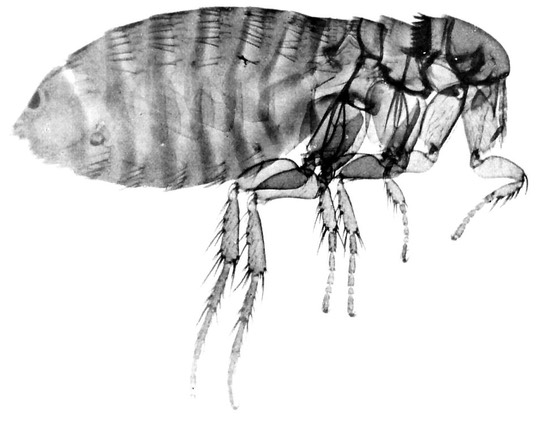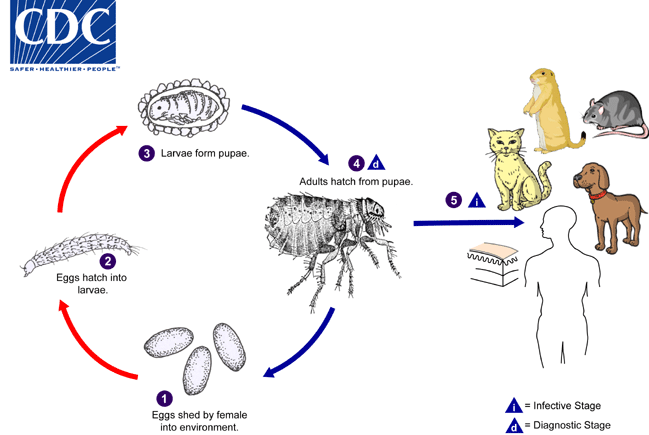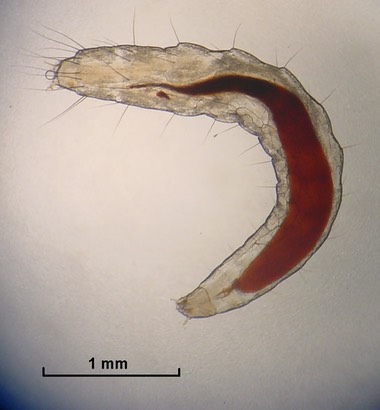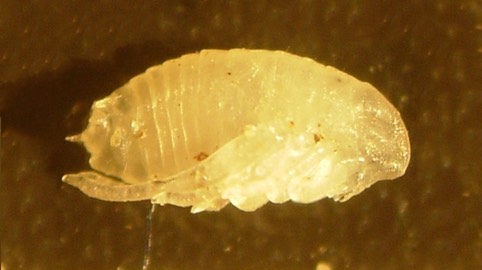Requires Special Treatment Methods
"Large numbers of pre-emergent fleas may be present in otherwise flea-free environments, and the introduction of a suitable host may trigger a mass emergence as experienced in vacant home and apartments with an infestation."
All About Fleas

Fleas are common external parasites of both dogs and cats. The adults are blood-feeders and is required for survival, they can consume up to 15 times their body weight in blood per day. Pets initially become infested when adult fleas occurring indoors or outdoors jump on an animal. With the ability to jump vertically up to about 6 inches, the adults hitch a ride onto a dog or cat, or even the shoes and pant legs of a human. Pets acquire fleas when visiting places like yards, when on a walk, other peoples home, kennels, groomers, etc. Stray dogs, cats or wildlife. Fleas are carried by opossums, raccoons, rats, mice etc. and while wandering through yards and property can deposit fleas.
Fleas unlike most household pests bite dogs and cats as well as humans. The bites can cause itching and irritation, and animals that are sensitive to the bites will often require veterinary care. Fleas can also cause tapeworms and bacterial infections. Fleas can reproduce at an extreme rate the biting adult stage might be living on a pet, in addition to hundreds or even thousands of eggs, larvae, and pupae in the home or yard. If signs of fleas are ignored, infestations can quickly go out of control.Contrary to popular belief, fleas seldom jump directly from one pet to another.
Biology Of Fleas
Fleas have a laterally compressed body, a tough, smooth cuticle with many backward-projecting bristles, and relatively long legs. The mouth parts of fleas include stylets that are used to pierce the skin of the host animal, so that a blood meal can be obtained by sucking.

Fleas Life Cycle

Fleas have a life cycle characterized by four developmental stages: egg, larva, pupa, and adult. (To the right and from the starting at the top: Larva, Egg, Pupa, and Adult of a Dog Flea)
The eggs are usually laid close to the body of the host in a place where the host commonly occurs, for example, on the ground, in a bird or mammal nest, or in carpets, cracks and crevices of flooring, or soft furniture in homes. Larval fleas have chewing mouth parts and feed on organic debris and the feces of adult fleas, while adults require meals of bird or mammal blood.
The number of eggs laid depends on species, with batch sizes ranging from two to several dozen. The total number of eggs produced in a female's lifetime varies from around one hundred to several thousand. In some species, the flea lives in the host's nest or burrow and the eggs are deposited on the substrate, but in others, the eggs are laid on the host itself and can easily fall off onto the ground. Because of this, areas where the host rests and sleeps become one of the primary habitats of eggs and developing larvae. The eggs take around two days to two weeks to hatch. Experiments have shown that fleas lay more eggs on hosts which have limited food intakes, and that eggs and larvae survive better under these conditions, perhaps because the host's immune system is compromised.

Flea larvae emerge from the eggs to feed on any available organic material such as dead insects, feces, other insects eggs, and vegetable matter. In laboratory studies, some dietary diversity seems necessary for proper larval development. Blood-only diets allow only 12% of larvae to mature, whereas blood and yeast or dog chow diets allow almost all larvae to mature. Another study also showed that 90% of larvae matured into adults when the diet included nonviable eggs.They are blind and avoid sunlight, keeping to dark, humid places such as sand or soil, cracks and crevices, under carpets and in bedding.The entire larval stage lasts between four to 18 days.

Given an adequate supply of food, larvae pupate and weave silken cocoons after three larval stages. Within the cocoon, the larva molts for a final time and undergoes metamorphosis into the adult form. This can take just four days, but may take much longer under adverse conditions, and there follows a variable-length stage during which the pre-emergent adult awaits a suitable opportunity to emerge this stage can be up to a year.
Trigger factors for emergence include vibrations (including sound), heat (in warm-blooded hosts), and increased levels of carbon dioxide, all of which stimuli may indicate the presence of a suitable host. Large numbers of pre-emergent fleas may be present in otherwise flea-free environments, and the introduction of a suitable host may trigger a mass emergence as experienced in vacant home and apartments with an infestation.
Once the flea reaches adulthood, its primary goal is to find blood and then to reproduce. Female fleas can lay 5000 or more eggs over their life, permitting rapid increase in numbers. Generally speaking, an adult flea only lives for 2 or 3 months. Without a host to provide a blood meal, a flea's life can be as short as a few days. Under ideal conditions of temperature, food supply, and humidity, adult fleas can live for up to a year and a half. A completely developed adult fleas can live for several months to a year without eating, so long as they do not emerge from their pupa stage see photo above. Optimum temperatures for the flea's life cycle 70 °F to 85 °F and optimum humidity is 70%.
Prevention of Fleas
Although there are many vectors for a flea infestation the most common factors are.
- Keep pets treated for fleas. There are many products on the market to prevent fleas from attaching to your pet.
- Foliage and debris in and around the properties produce safety from sun and heat and provides moisture. Make sure your property is free of loos leaf litter and foliage on the ground and remove.
- Compost near pet areas and home. Keep them away from home and pets.
- Keeping opossums, raccoons, rats, mice etc. from establishing safe harborage in and or around your home.
- Keep lawn at a reasonable length. Ungroomed lawns and high grass provides shade and safe harborage.
- In the home keep clutter under control.
- Vacuum, Vacuuming causes noise, heat and vibrations and is a necessary tool to control and rid flea infestations.
- Place pieces of a cut up flea collar in the vacuum bag or container. Remove vacuum bag from home immediately or incase of bagless vacuum empty and dispose of immediately placing a new piece of flea collar in bag or container.
- Place pieces of a cut up flea collar under cushions of couches and chairs, and under mattresses.
Hiring Pest Management Professionals
Getting a pest management professional (PMP) involved as soon as possible rather than taking time to try to treat the problem yourself, they are very effective at preventing further infestations. Each pest management company should have instructions for residents on how to prepare for the treatment which should include lots of vacuuming.